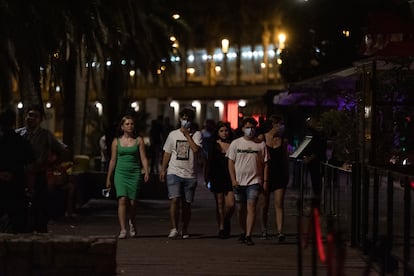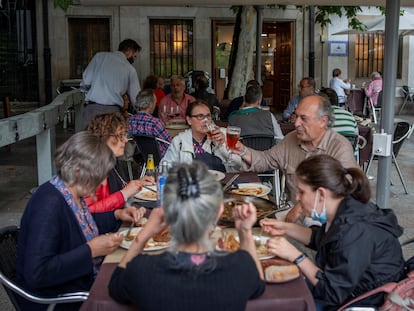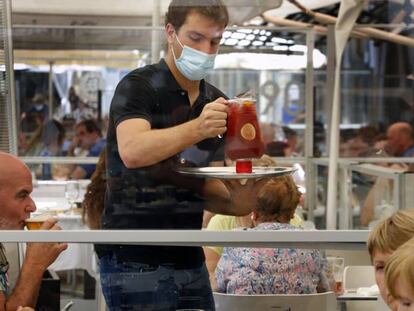How can Spain slow its fifth wave of the coronavirus?
With the incidence among 20- to 29-year-olds as high as 911 cases per 100,000 inhabitants, experts argue that efforts should be made to cut infections among this age group, with measures focusing on nightlife, education and tracing

The fifth wave of the coronavirus in Spain is different to the previous four. The latest spike in infections has happened at an unusual speed, but among a very specific group of the population: young people aged under 30. This has happened for two main reasons: the type of social interaction in which this section is engaging in Spain, and the high vaccination rates among older people. With a large part of the most vulnerable citizens now protected thanks to the shots, any measures to combat this new wave will have to be aimed at the age groups where the virus is spreading, experts consulted by EL PAÍS all agree. In the 20-29 group, the cumulative incidence reached 911 cases per 100,000 inhabitants in 14 days, three times higher than the national average.
All eyes have turned to the nightlife sector – whether it be bars and restaurants, or improvised celebrations such as parties or botellones, as street drinking gatherings are known in Spain. Some of Spain’s regions – which are in charge of their coronavirus measures, as well as their healthcare systems and vaccination programs – are already taking action, by limiting timetables, capacity and prohibiting some activities. Valencia’s administration wants to go even further, and has turned to the courts for permission to implement a curfew in areas with the highest incidence.
Public health experts believe that the intervention of nightlife activities is necessary
Such a measure may be efficient when it comes to limiting socializing and the transmission of the virus, but it has little support – neither the central government, the majority of the regions nor the political opposition have backed a similar move. A curfew would infringe on fundamental freedoms, and has only been imposed previously under the state of alarm put in place by the central government. With the pressure on Spain’s healthcare system still low – 2.35% of regular hospital beds are occupied by Covid-19 patients, along with 6.55% of intensive care unit (ICU) beds – the country is not currently in that scenario.
Public health experts believe that the intervention of nightlife activities is necessary, whether this involves the closure of nightclubs, indoor spaces, regulation of opening times or nighttime closures of parks and beaches to avoid street drinking.
But more action is needed, they agree. “We need to make an effort to educate,” explains José Martínez Olmos, a professor at the Andalusian School of Public Health. “We cannot think that young people are not sensitive to what is happening. We have to seek out methods to convey the message of how infections can reach their environment, also using social media and in the spaces where they communicate, and manage to empathize with them.”
The risk of suffering a severe case of Covid-19 falls with age. This is the most clearly correlated factor with hospital or ICU admissions or with deaths. The statistics from other waves, as collated by the Carlos III Health Institute, say that approximately one in every 100 people aged between 10 and 30 who are infected require hospitalization; one in every 2,000 will need intensive care; and one in every 15,000 will die (the probabilities among the 20-29 group are roughly two to four times higher compared to adolescents).
While the percentages are small, if the wave continues to grow exponentially as it has until now, there will be tens (if not hundreds) of new cases, which will bring with them a proportional number of admissions and deaths. What’s more, the incidence will grow among older people who are in contact with this population, whether they are vaccinated and have not yet reached full protection or are yet to receive their two doses (that’s the case for four in every 10 people aged 60-69).
Epidemiologists do not believe that the country’s hospital system will become overloaded as it was during other waves, nor that ICU’s will be overwhelmed, but they do point out that the primary healthcare system is stretched to its limit and that the probabilities of a mutation emerging that evades the protection of the current vaccines are greater the more the virus circulates.
These figures and reasons are being cited by public health experts as to why the virus should not be allowed to spread uncontrolled, as British Prime Minister Boris Johnson has this week proposed once again. England will be lifting all coronavirus restrictions from July 19 onward, on the basis of the high rates of vaccination in the United Kingdom – 50% of the population has both doses – and the low risk for young people. A group of scientists, however, this week published a letter in the medical journal The Lancet against this approach, titled “Mass infection is not an option: we must do more to protect our young.”
While the 14-day cumulative number of coronavirus cases per 100,000 inhabitants is now at maximum alert level, the other factors required for an overall higher risk level have not been registered
One of the signatories of the text is José María Martín Moreno, a professor of preventive medicine and public health at the University of Valencia. He explains to EL PAÍS that he believes it is necessary to close nightlife venues and restrict timetables, but that it is also key to insist on the non-pharmacological pillars to stop the virus’s spread: testing, tracing cases, isolating the infected and isolating contacts.
That appears to be the approach that the central Health Ministry is taking, having made five million antigen tests available to the regions, and deploying army contact tracers to help cut the chains of transmission among young people. The central government has ruled out coordinated action across the country apart from those that the regions can already implement based on their epidemiological situation. Health Minister Carolina Darias has pointed to the so-called traffic light system put together by her ministry, which sets out measures such as the closure of interior spaces or nightlife in areas where risk levels are high.
According to the latest data, however, all regions are currently at low or very low risk. While the 14-day cumulative number of coronavirus cases per 100,000 inhabitants is now at 277, which is the maximum alert level, the other factors required for an overall higher risk level have not been registered, such as pressure on hospitals.
This is why the approach to this wave needs to be different. Measures based on lockdowns “would be absurd,” argues Martín Moreno. Rafael M. Ortí Lucas, the president of the Spanish Society of Preventive Medicine, Public Health and Hygiene (SEMPSH), insists that action should be taken where the reservoirs of the virus are located. “Above all in the affected population group, in the evening-nighttime time slot,” he explains. “That could be botellones, nightlife, parties, or even evening tapas and drinks in some cities. That’s where there is transmission. And the measures that we know need to be observed: distance, barriers [i.e. masks] if we are inside, and ventilation. It’s easy now in the summer. If we can achieve this, that’s great. If not, we will have to use measures that have worked such as the curfew or prohibiting crowds. If things continue like this, we will not be able to forego [these restrictions].”
Responsible leisure
Adrián Hugo Aginagalde, a spokesperson from the SEMPSH, is also not ruling out that more resounding action will have to be taken if the incidence continues to grow. But before that happens, he proposes implementing programs of responsible leisure for the evenings and nighttimes: culture, outdoor activities and sport, pursuits that have already been used in campaigns against drug use among young people. “It does not seem plausible that the incidence will fall easily over the next two weeks,” he argues. “Beyond that, it is difficult to predict, but we know that a wave can be controlled using non-pharmacological measures between two and four weeks.
Would it make sense to prioritize vaccination among young people? In the opinion of Aginagalde, no. “Too much time would pass before they had the full protection [offered by the vaccines], and with the [more contagious] delta variant the priority is to complete the vaccination of everyone who has one dose, especially among older people.”
English version by Simon Hunter.
Tu suscripción se está usando en otro dispositivo
¿Quieres añadir otro usuario a tu suscripción?
Si continúas leyendo en este dispositivo, no se podrá leer en el otro.
FlechaTu suscripción se está usando en otro dispositivo y solo puedes acceder a EL PAÍS desde un dispositivo a la vez.
Si quieres compartir tu cuenta, cambia tu suscripción a la modalidad Premium, así podrás añadir otro usuario. Cada uno accederá con su propia cuenta de email, lo que os permitirá personalizar vuestra experiencia en EL PAÍS.
¿Tienes una suscripción de empresa? Accede aquí para contratar más cuentas.
En el caso de no saber quién está usando tu cuenta, te recomendamos cambiar tu contraseña aquí.
Si decides continuar compartiendo tu cuenta, este mensaje se mostrará en tu dispositivo y en el de la otra persona que está usando tu cuenta de forma indefinida, afectando a tu experiencia de lectura. Puedes consultar aquí los términos y condiciones de la suscripción digital.
More information
Últimas noticias
Most viewed
- Reinhard Genzel, Nobel laureate in physics: ‘One-minute videos will never give you the truth’
- Oona Chaplin: ‘I told James Cameron that I was living in a treehouse and starting a permaculture project with a friend’
- Pablo Escobar’s hippos: A serious environmental problem, 40 years on
- Charles Dubouloz, mountaineering star, retires at 36 with a farewell tour inspired by Walter Bonatti
- Why we lost the habit of sleeping in two segments and how that changed our sense of time











































